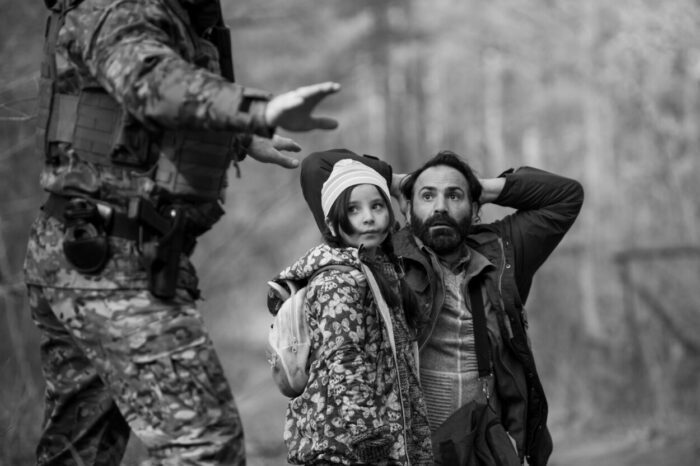Urgency is the hallmark of Green Border, the new film by Agnieszka Holland about the refugee crisis at the Belarusian-Polish border. Set in 2021 in a vast forested zone that has become an inescapable and tortuous purgatory for those fleeing the Middle East and Africa, the film is presented in four interlocking parts. Each attempt to make visible the physical and emotional struggle of those involved in this harrowing and often invisible crisis.
Part one is “The Family,” which introduces us to Syrian refugees Bashir (Jalal Altawil) and Amina (Dalia Naous), their three children, and Bashir’s father (Al Rashi Mohamad). Their promise of passage to Sweden quickly deteriorates after hastily being extorted at the Polish border by a Belarus transport driver. Leila (Behi Djanati Atai), a fellow asylum seeker from Afghanistan, pays the driver 300 euros, and from there joins the family as they are jettisoned into the treacherous and swampy borderland with little resources. Eventually, the journey of the family is used to show the audience the horrific and repetitive mechanism of warfare the green border has become. The Belarus military extort asylum seekers as they provide passage through thick strands of razor wire into the borderland, and the Polish border guards round up the refugees and push them back over the border in an endless, dehumanizing loop.

For Holland to show the stark journey of a Syrian family would be enough, but the filmmaker beautifully folds in the experiences and perspectives of those involved on various fronts of the crisis through the subsequent chapters. Part 2 is “The Border Guard,” involving Jan (Tomasz Włosok) and his traumatic struggle to reconcile what he witnesses through his position of authority with being an expectant father. Part 3 is “The Activists,” involving a highly nuanced look at the operations and risks of border activists and medics. Lastly, Part 4 brings us to “Julia,” (Maja Ostaszewska) a psychiatrist who lost her husband to COVID and can no longer ignore the tragedy happening just beyond her back door.
Ostaszewska’s performance is particularly noteworthy, especially since her character is introduced late in a 2 and ½ hour film. Even so, Green Border earns every minute of its runtime, deftly maintaining balance between each dramatic thread it establishes, from the initial journey of the Syrian family to the events that lead Julia toward the enclave of activists and into the forest. Likewise, each strand of the film creates a cumulative impact that seems effortless, right through to the brief but crucial epilogue of the film that takes us to the very recent conflicts at the Ukrainian border.

The expansiveness of perspective and adeptness at balancing multiple characters in Green Border is no doubt a relative of the groundbreaking television show The Wire, on which Holland directed three episodes. The film also feels like a companion piece to another masterwork within her long career, the 1990 film Europa Europa, about a young man concealing his Jewishness to survive within the culture of Nazi youth. That Holland has now made a film in her mid-70’s as succinctly subversive and politically risky as Green Border deserves endless applause.
Instead, Holland has been met with propagandistic attacks by Polish officials. To be clear, Holland shot and released the film as an activist gesture, completing the film in a whirlwind 22-day shoot with cinematographer Tomasz Naumiuk and releasing it just before the 2023 Parliamentary election in Poland. In one instance of resistance to the film, Polish Justice Minister Zbigniew Ziobro took to the social media platform X to compare Holland to Josef Goebbels, stating:
“In the Third Reich, the Germans produced propaganda films showing Poles as bandits and murderers. Today, they have Agnieszka Holland for that.”
While premiering the film at various festivals—most notably winning the Golden Lion in Venice—Holland’s humanitarian efforts as a filmmaker have necessitated her being accompanied by bodyguards. This is something to remember the next time you hear filmmakers like David Fincher or Michael Bay talk about the “huge risks” they take in getting their movies made. For filmmakers like Holland—or the famously banned Jafar Panahi in Iran—giving voice to the voiceless through their work is nothing short of laying their lives on the line.
Because Green Border was made with such urgency and under clear opposition by the Polish government, it’s important to conclude by noting how beautifully the film is written and how stunning it is stylistically. I often joke that my least favorite kind of movie is a so-called “important” one, but there’s a truth in that joke that Green Border absolutely transcends. The film is far from a brand of tragedy porn designed for audiences to give themselves a pat on the back on the way out of the theater for having endured.
True, the situations are harrowing, but the narrative progression of the film is so engrossing that the genius of Naumiuk’s black-and-white—seemingly etched-in-charcoal—cinematography might not fully land with you until late in the film. Or, the subtle and literary way the script weaves the animal realm into each movement, the naturalistic counterbalance to the horrors of war. For instance, Jan encountering a white wolf outside of a makeshift refugee campsite, or a simple yet profound visual transition of a line of birds flying borderless. With a script that was completed in two months, shot in less than a month, and using many actual refugees as actors, Green Border is an almost impossibly successful work of activist art. It was made with an undeniable urgency, but plays like a film constructed with all the time and patience in the world. The final urgency is that we witness it, because it’s rare for a film to show us so artfully atrocities that should not remain unseen.



